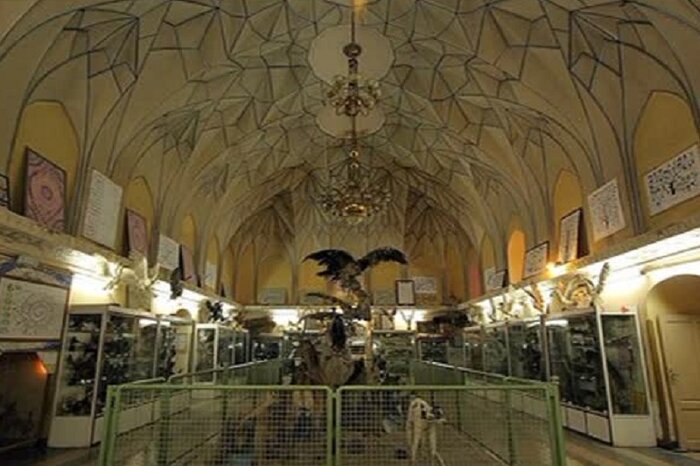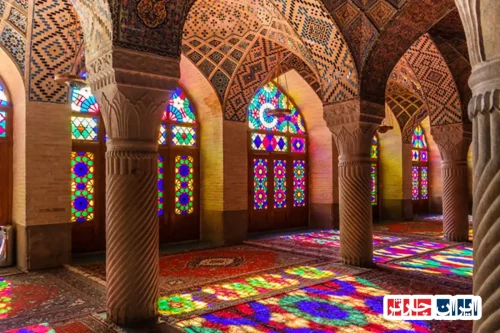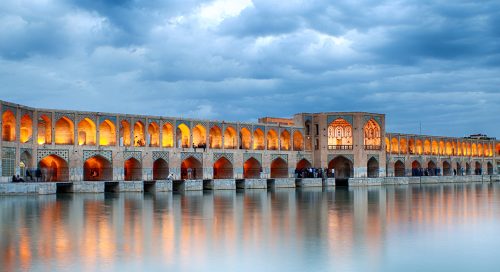News Source : https://www.irna.ir/news/85671406/%D8%AA%D8%A7%D9%84%D8%A7%D8%B1-%D8%AA%DB%8C%D9%85%D9%88%D8%B1%DB%8C-%D8%A8%D9%87-%D9%85%DB%8C%D8%B1%D8%A7%D8%AB-%D9%81%D8%B1%D9%87%D9%86%DA%AF%DB%8C-%D8%A7%D8%B5%D9%81%D9%87%D8%A7%D9%86-%D9%88%D8%A7%DA%AF%D8%B0%D8%A7%D8%B1-%D8%B4%D8%AF
The Timuri Hall transferred to Isfahan’s Cultural Heritage
The ownership document of the historic ‘Timuri Hall’ has been handed over to Isfahan’s cultural heritage. This building, which was known for years as the ‘Isfahan Natural History Museum,’ is now transferred to the Ministry of Cultural Heritage. This move provides an excellent opportunity for the preservation and restoration of this building. Experts believe that transferring ‘Timuri Hall’ can establish suitable foundations for turning it into a traditional arts museum or other cultural functions. With the ownership transfer, the Isfahan Cultural Heritage Department will be able to more precisely plan for the maintenance and preservation of this historical monument.
The transfer of ‘Timuri Hall’ to Isfahan’s cultural heritage indicates the serious attention of the government to preserve the country’s cultural and historical heritage. This ownership transfer has enabled better public and tourist utilization of this complex. Ultimately, the handover of ‘Timuri Hall’ to Isfahan’s cultural heritage is considered a significant step towards preserving and promoting Isfahan’s cultural heritage.
History of Transferring the “Timuri Hall” to Isfahan’s Cultural Heritage
The transfer of the “Timuri Hall” to Isfahan’s Cultural Heritage marks a significant milestone in the preservation and maintenance of historical buildings in Isfahan province. Previously serving as the “Natural History Museum of Isfahan,” this historic hall is now under the purview of the Ministry of Cultural Heritage of Isfahan. The transfer of ownership to this institution has enabled the restoration and preservation of the historical structures of the Timuri Hall, facilitating its transformation into a specialized museum of traditional arts. Experts believe this transfer of ownership is a crucial step towards enhancing the cultural and historical landscape in Isfahan and safeguarding the historical and cultural values of this building for future generations.
The Role of Isfahan’s Cultural Heritage in Preserving Timuri Hall
With the transfer of the “Timuri Hall” to the Directorate of Cultural Heritage of Isfahan Province, this organization has taken on the responsibility of preserving and maintaining this historical monument. The department, leveraging its experience and expertise, has initiated comprehensive restoration and preservation programs for the Timuri Hall. The main aim of these initiatives is to prevent potential deterioration and preserve the historical authenticity of the building. Additionally, the cultural heritage of Isfahan intends to transform the Timuri Hall into a dynamic cultural center related to contemporary arts, potentially making it a tourist attraction.
Future Developments of “Timuri Hall” After the Transfer
Following the transfer of “Timuri Hall” to Isfahan’s Cultural Heritage, the building is expected to become a notable museum in the fields of traditional arts and natural history. Planned developments include organizing permanent and temporary exhibitions, conducting educational workshops, and creating suitable spaces for cultural and artistic activities. Furthermore, the management of Isfahan’s Cultural Heritage aims to collaborate with local and international institutions to implement joint projects that enhance the quality of exhibitions and better preserve artistic works.
The Historical Significance of “Timuri Hall” in Isfahan
“Timuri Hall” is one of Isfahan’s significant historical buildings, dating back to the Safavid era of the state house. In recent years, it functioned as the “Natural History Museum of Isfahan,” but it lacked direct relevance to Isfahan’s history and traditional arts. The transfer to cultural heritage has highlighted the historical significance of this hall, turning it into a symbol of efforts to preserve and enhance the cultural heritage of Isfahan province. Visiting this building provides an excellent opportunity to learn more about Isfahan’s rich history and culture.
Challenges Faced by the Cultural Heritage Administration in Maintaining “Timuri Hall”
With the ownership transfer of “Timuri Hall” to Isfahan’s Cultural Heritage, the administration faces several challenges. These include the need for sufficient financial resources for restoration and preservation, finding experts in historical painting and traditional design, and attracting investors and financial supporters for developmental projects. Additionally, the Cultural Heritage Administration must devise effective programs to attract tourists and raise public awareness about the historical importance of the Timuri Hall.
Educational and Cultural Programs in “Timuri Hall” Post Transfer
One of the primary objectives of Isfahan’s Cultural Heritage Administration following the transfer of “Timuri Hall” is to create an educational and cultural space for the community. The educational programs include specialized courses in natural history, traditional arts, and cultural heritage management, organized in collaboration with reputable universities and educational institutions. Moreover, hosting cultural events such as concerts, art exhibitions, and historical seminars in this hall can increase visitor appeal and play a crucial role in enhancing the culture and art level of Isfahan.
Impact of the Transfer of “Timuri Hall” on Isfahan’s Tourism
The transfer of “Timuri Hall” to Isfahan’s Cultural Heritage has positive effects on the province’s tourism industry. Transforming this building into a specialized museum in traditional arts and natural history can introduce it as a new tourist attraction, increasing the number of visitors. This initiative, in addition to boosting tourism revenue, enhances Isfahan’s reputation as a historically and culturally credible city among domestic and international tourists. As the Cultural Heritage Administration of Isfahan implements its developmental programs, these positive impacts are expected to become more apparent in the coming years.
Restoration and Preservation Efforts on “Timuri Hall” Post Transfer
After the transfer of “Timuri Hall” to Isfahan’s Cultural Heritage, extensive restoration and preservation efforts have been undertaken on this building. Restoration specialists, using modern techniques and high-quality materials, have focused on reviving historical structures and preventing potential decay. These efforts include reinforcing the main structures, restoring stone facades, and reconstructing architectural details of the Timuri Hall. Additionally, modern protective systems have been installed to prevent damage from climatic changes and other environmental factors.
The Role of the Local Community in Preserving Timuri Hall
The preservation and maintenance of “Timuri Hall” are not solely the responsibility of Isfahan’s Cultural Heritage Administration; the local community also plays a vital role in this process. Collaborating with local writers, artists, and cultural activists to create joint programs and garner public support can aid in better preserving this historical monument. Additionally, organizing public events and raising cultural awareness among Isfahan residents can foster a deeper connection between the community and the city’s cultural heritage, ultimately ensuring local loyalty in preserving the Timuri Hall.
Suggestions for Optimizing the Use of “Timuri Hall” Post Transfer
To optimize the use of “Timuri Hall” after its transfer to Isfahan’s Cultural Heritage, several suggestions have been proposed that could attract more visitors and enhance the quality of the building’s maintenance. These suggestions include creating various museum sections corresponding to different historical periods of Isfahan, organizing periodic exhibitions on diverse themes, and developing visitor amenities. Moreover, employing modern technologies in exhibitions and creating interactive educational programs could improve visitors’ experience and increase their satisfaction.
FAQ
- What is Timuri Hall and what was its function?
- Timuri Hall is a historical building within the Safavid statehouse in Isfahan, which for years was known as the Natural History Museum of Isfahan, housing a collection of various objects and taxidermy.
- To which ministry was the ownership document of Timuri Hall issued?
- The ownership document of Timuri Hall was issued to the Ministry of Cultural Heritage of Iran and the usage rights were assigned to the Directorate of Cultural Heritage, Tourism and Handicrafts of Isfahan Province.
- Why is Timuri Hall no longer recognized as a Natural History Museum?
- Experts believed that the Natural History Museum did not have a significant connection to the historical building of Timuri Hall, necessitating restoration and an appropriate repurpose.
- What is the background of establishing the Natural History Museum in Timuri Hall?
- In the late 1980s, the municipality of Isfahan handed over Timuri Hall to Mohammad Ali Jafarian, a geologist and paleontologist, to assemble a collection of natural history there.
- What changes have been made to Timuri Hall this year?
- This year, the Isfahan Urban Renewal Organization has conducted damage assessment and emergency restoration operations on Timuri Hall.
- What have students and handicraft activists requested from Timuri Hall?
- Students and handicraft activists have long requested the restoration and repurpose of Timuri Hall into a traditional arts museum or similar.
- What did the Director General of Isfahan’s Cultural Heritage say about the Timuri Hall ownership document?
- Amir Karamzadeh stated that with the issuance of the ownership document, better protection and restoration of the collection is enabled, emphasizing serious pursuit of registering ownership of the province’s key historical artifacts.
- What area does the Timuri Hall ownership document cover?
- The ownership document covers the Timuri Hall building and the surroundings and appurtenances of the collection, with an area exceeding 80,000 square meters.
- What actions have been taken after acquiring the ownership document for the Risbaf complex?
- After acquiring the ownership document for the Risbaf complex, the review of historical documents for 20 significant historical collections in Isfahan province began.
- How long did it take to issue the ownership document for the historic Chehel Sotoon building?
- The ownership document for the historic Chehel Sotoon building was issued after 94 years.
- Under which organization will Timuri Hall be managed?
- Timuri Hall will be managed by the Directorate of Cultural Heritage, Tourism and Handicrafts of Isfahan Province.
- Who played important roles in the preservation and restoration of Timuri Hall?
- The Isfahan Urban Renewal Organization and the Director General of Isfahan’s Cultural Heritage played important roles in the preservation and restoration of Timuri Hall.
- What was the function of Timuri Hall before being converted into the Natural History Museum?
- Before being converted into the Natural History Museum, Timuri Hall was part of the Safavid statehouse in Isfahan, comprising extensive buildings and grounds.
- What reasons led to the disconnect between the Natural History Museum and Timuri Hall?
- Experts believed that the Natural History Museum did not have a significant connection to the historical building of Timuri Hall, highlighting the need for repurpose and restoration.
- What role did Mohammad Ali Jafarian play in Timuri Hall’s history?
- Mohammad Ali Jafarian, a geologist and paleontologist, assembled a significant natural history collection in Timuri Hall, playing a key role in its transformation into the Natural History Museum.







